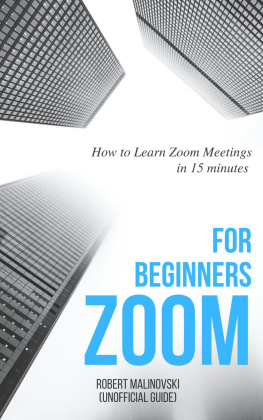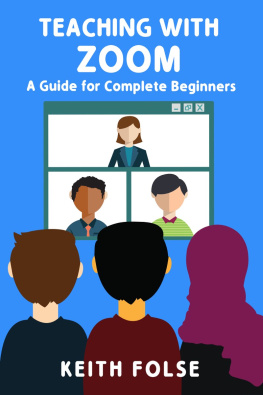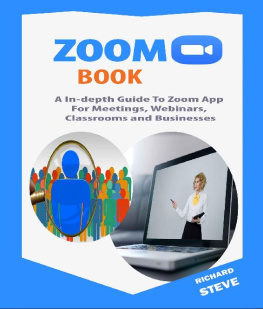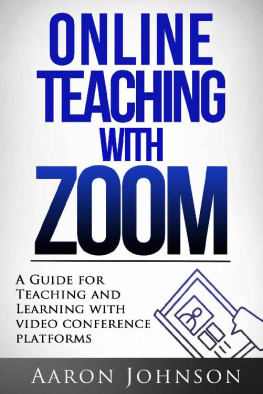Madison Salters - Introduction to Teaching with Zoom
Here you can read online Madison Salters - Introduction to Teaching with Zoom full text of the book (entire story) in english for free. Download pdf and epub, get meaning, cover and reviews about this ebook. year: 2020, publisher: Ulysses Press, genre: Home and family. Description of the work, (preface) as well as reviews are available. Best literature library LitArk.com created for fans of good reading and offers a wide selection of genres:
Romance novel
Science fiction
Adventure
Detective
Science
History
Home and family
Prose
Art
Politics
Computer
Non-fiction
Religion
Business
Children
Humor
Choose a favorite category and find really read worthwhile books. Enjoy immersion in the world of imagination, feel the emotions of the characters or learn something new for yourself, make an fascinating discovery.

- Book:Introduction to Teaching with Zoom
- Author:
- Publisher:Ulysses Press
- Genre:
- Year:2020
- Rating:5 / 5
- Favourites:Add to favourites
- Your mark:
- 100
- 1
- 2
- 3
- 4
- 5
Introduction to Teaching with Zoom: summary, description and annotation
We offer to read an annotation, description, summary or preface (depends on what the author of the book "Introduction to Teaching with Zoom" wrote himself). If you haven't found the necessary information about the book — write in the comments, we will try to find it.
Introduction to Teaching with Zoom — read online for free the complete book (whole text) full work
Below is the text of the book, divided by pages. System saving the place of the last page read, allows you to conveniently read the book "Introduction to Teaching with Zoom" online for free, without having to search again every time where you left off. Put a bookmark, and you can go to the page where you finished reading at any time.
Font size:
Interval:
Bookmark:


For Kristine, a wonderful teacher and a better friend,and Jess, upon whose acta sanctorum I was able to complete this.
The physical classroom space has been expanding for years to incorporate more and more technology as computers and applications become central to the lives of students and professionals, advancing us into the age of digital distance learning. As forbidding as this may seem at first glance, the scope of education has rarely been limited to the classroom: additional readings, homework assignments, hands-on activities, field trips, and out-of-school time that includes clubs, study groups, and after-school classes have long been essential supplementary pillars to well-rounded study. Distance learning, whether a replacement for classroom learning or a supplement to it, offers rich and varied opportunities that teachers may not have access to in a classroom setting.
Distance learning need not be viewed with apprehension. This book guides teachers, students, and parents in best practices for combining distance learning elements with the free video application tool Zoom. For you, the teacher, it will suffuse your syllabus with a broader range of learning methods and tools, whether you are teaching kindergartners or college students, whether your subject is math or music. Far from a crutch used only when school systems are hurting, distance learning via Zoom can make education more limitless than ever before.
One key benefit of distance learning is that, for the first time, teaching no longer need be restricted by time, place, or certain budgetary limitations. Whether you are using distance learning to enhance in-person education or as a fallback for use during snowstorms, pandemics, and utility disasters, it provides a rare space where you have tremendous control over how you present your curricula. Zoom teaching in particular gives instructors an opportunity to flex their creativity, crafting an online space that works best for their subject, driven by more individualized pacing based on their students. It offers better flexibility, originality, and immediate auxiliary resources, like PDFs and online libraries. With the correct road map, distance learning can be the place todays teachers go to forge the very future of learningYOU will get to decide, in part, what that future looks like. You are on the frontier.
The first step in mastery is understanding exactly what distance learning is. To do that, lets contrast it with something the modern classroom is already a little more familiar with: online learning.
Elements of distance learning were already gaining traction before the COVID-19 pandemic plunged the globe into an emergent need for online classrooms. We can recognize the trend in the advent of online universities and the rising popularity of digitally taught college-level and continuing education courses. Unfortunately, this mode of education has often come with the unfair stigma of lesser, even as enrollment has soared thanks to its accessibility, its flexibility, and, often, the lower costs of class materials. Technology is an undeniable fact of life, and distance learning has allowed nations across the globe to give students and young people access to an education in the midst of a pandemic, safeguarding them as well as staff and teachers during the worst of it. The trick to understanding how distance learning can be uniquely supplemental, parallel, or equal to in-person teaching is to understand the pros and cons of distance learning versus online learning, which teachers of K12 students will be more used to. Online learning has its own set of tactics, which have to be modified or unlearned to approach proper distance learning.
You or your students likely have already been utilizing online learning. Online learning is categorized by the incorporation of technology into the physical classroom and the after-school space: anything from in-class tools like smart boards for teachers, school Wi-Fi, and school-loaned tablets or laptops to prerecorded lecture clips, digital notes and slide shows, school home pages and school-held social media to keep up with events and announcements, teacher email addresses, and even online resources for taking and grading tests and quizzes. Many schools, especially universities, use online forums like SPIRE to keep track of grades and allow students to submit homework digitally and access syllabisomething becoming more common in high schools as well. Its this high-fi/low-tech mishmash that categorizes online learning: education in a physical space, enhanced by technology.
Distance learning, by contrast, turns that idea completely on its headits purely technological learning, sometimes supplemented by the physical. It offers a completely new experiencethink of it as its own genre. The classroom exists entirely in a digitized space, like the Zoom classroom, supported by a virtual library of tools and materials. In contrast to online learning, distance learning can be augmented with nondigital raw materials, such as books, snail-mailed packets (of bulk homework or graded essays, for example, for students who have less access to technology), and hands-on experiences like cooking, jogging, and physical note-taking.
Some other key differences include:
- 1. Strategy. Online learning treats technology as an auxiliary tool, an alternative style that can be used or discarded without much effect within the lesson. In distance learning, the digital tools are a must, and having everyone learn using the same set of tools will make your classroom more cohesive and collaborative. Proficiency in these tools is expected over time, and new tools may be added as they become available. Students will even learn how to suggest their own, and the addition of new tools will become common and organic in distance learning, whereas they are acquired less quickly and smoothly in online learning, and sometimes only the teacher need be proficient.
- 2. Collaborative studying. The in-person collaboration of online learning is usually limited to a few hand-raising questions and group work. However, studies show that age groups that work together on problems are more likely to come to correct conclusions and flex critical thinking skills. If done correctly, digital learning can be extremely collaborative. It employs video chats, breakout rooms, private messages, school and individual class message boards, and, often, the online individualized Learning Management System (LMS) of your school. It encourages discussion between peers at a much higher rate than an oft quiet classroom environment might, also encouraging after-class discussion at willno longer restricted to just the class period or the school day or school environment.
This style of learning has many benefits, which you will discover as you grow used to the tactics discussed in these pages and become comfortable in your own Zoom classroom.
Some key benefits of distance learning include the following:
- 1. Relevant and relaxed learning. Technology is already such a vital part of students out-of-school lives that they may feel more comfortable using a set of tools they are already immersed in, especially since computing will matter so much to their future professional and social lives. Distance learning will help integrate both application use and cloud-based ways of thinking and researching into their daily lives, making these activities feel like second nature to them. And whereas a classroom setting might be difficult and uncomfortable for some studentssilent, stifling, requiring constant attention, and sometimes encouraging bullyinga digital learning environment allows students, in many cases, to pick a setting in which they are most comfortable learning and gives them the privacy to occasionally goof off in a way that may allow them to refocus. While cyberbullying can be problematic, in many cases students can more readily provide evidence in the form of screenshots and can work with parents and teachers to resolve it.
Font size:
Interval:
Bookmark:
Similar books «Introduction to Teaching with Zoom»
Look at similar books to Introduction to Teaching with Zoom. We have selected literature similar in name and meaning in the hope of providing readers with more options to find new, interesting, not yet read works.
Discussion, reviews of the book Introduction to Teaching with Zoom and just readers' own opinions. Leave your comments, write what you think about the work, its meaning or the main characters. Specify what exactly you liked and what you didn't like, and why you think so.




